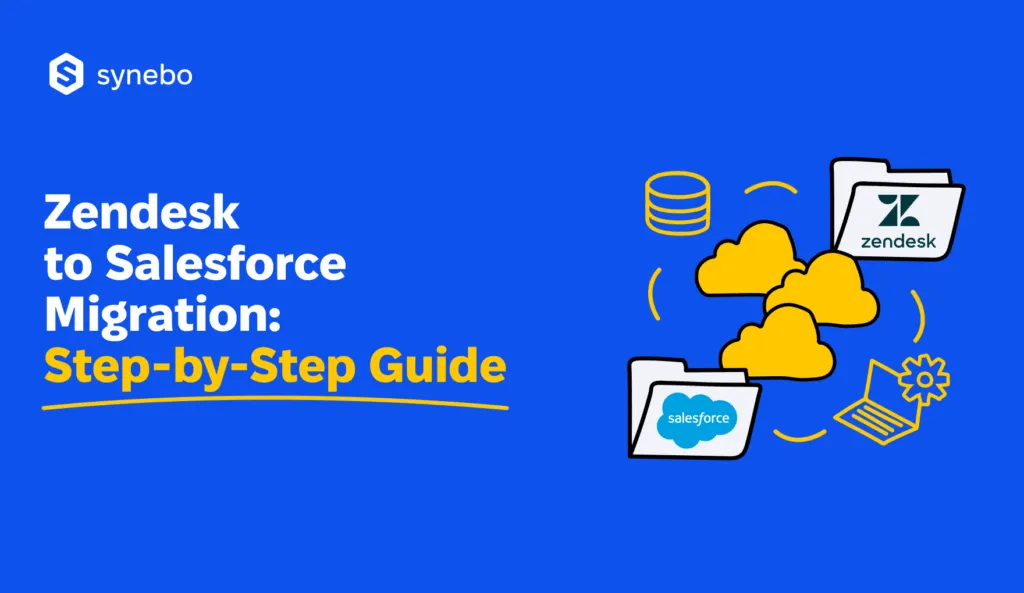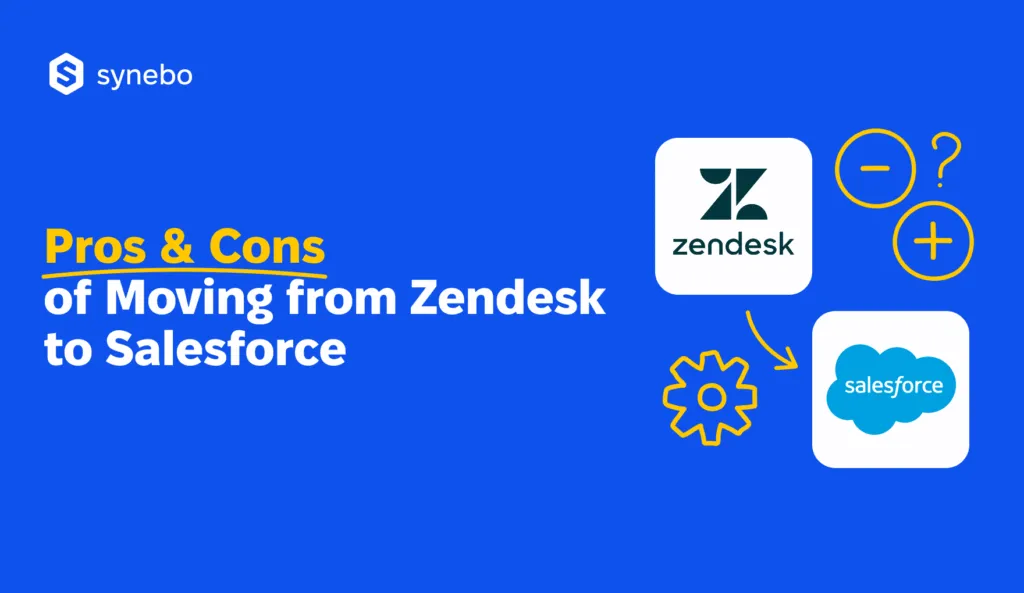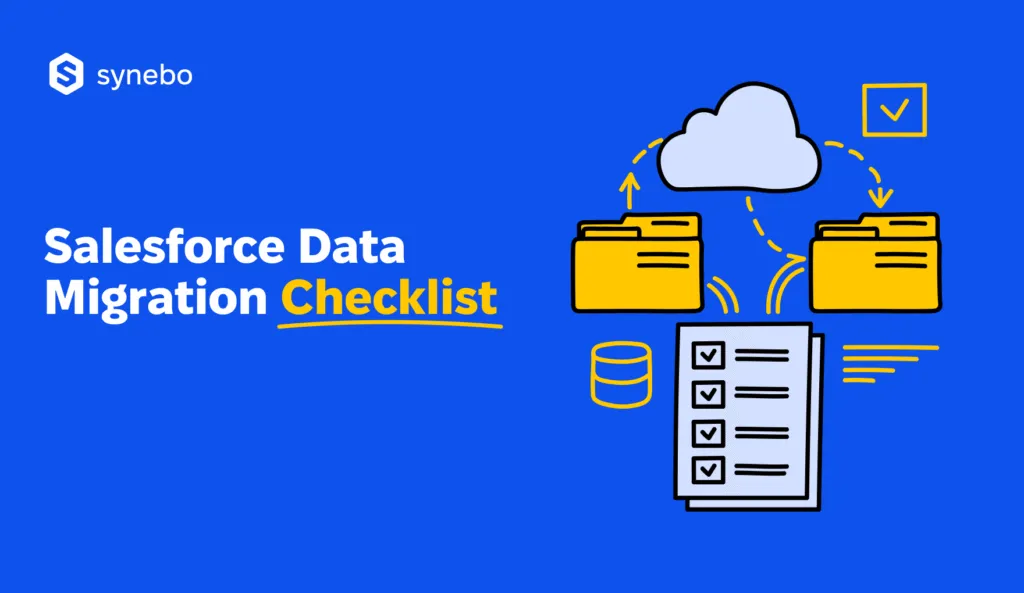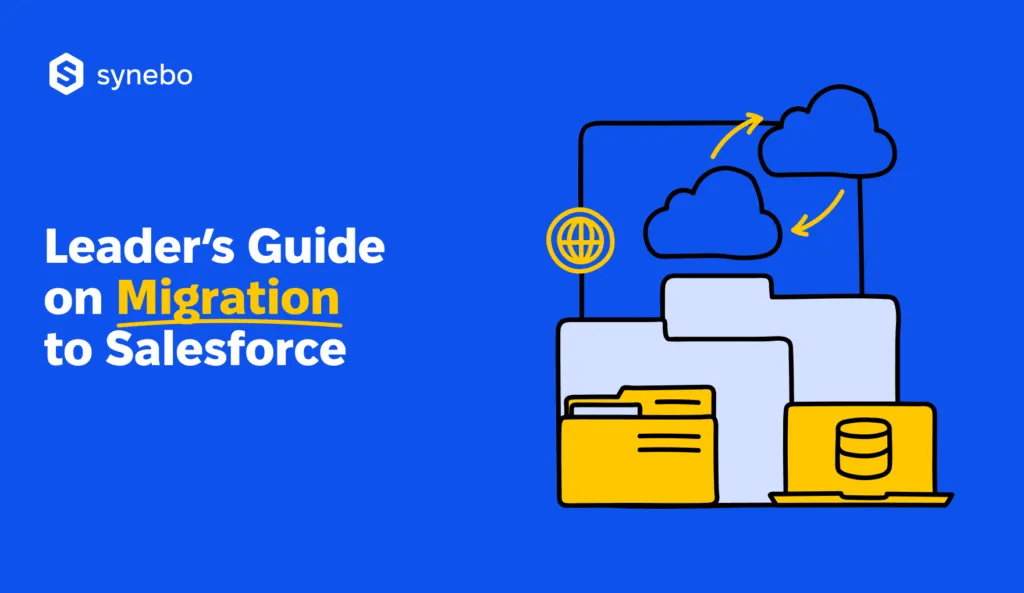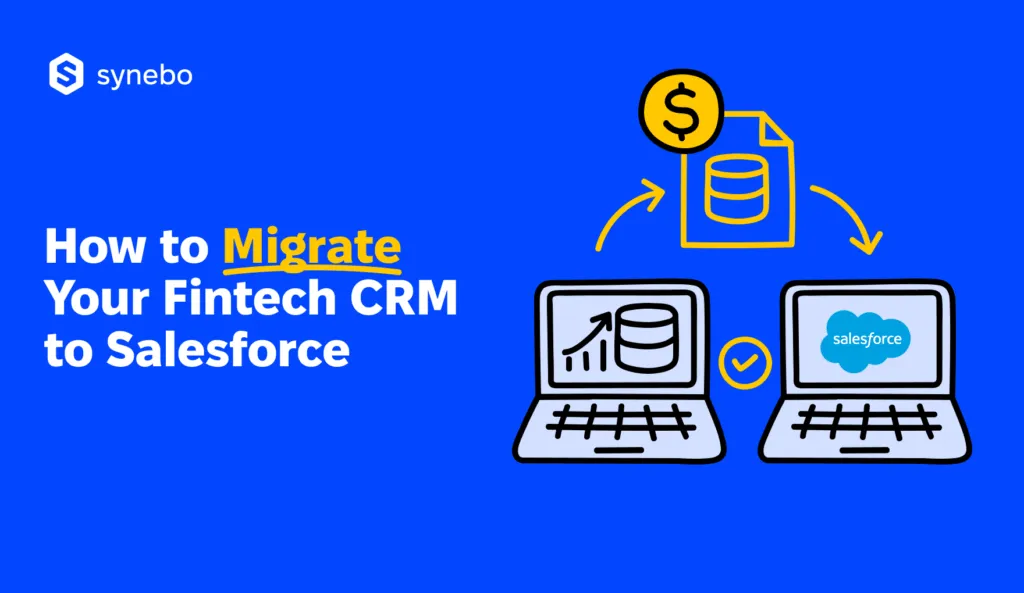From Zendesk to Salesforce: Data Migration Challenges and How to Solve Them
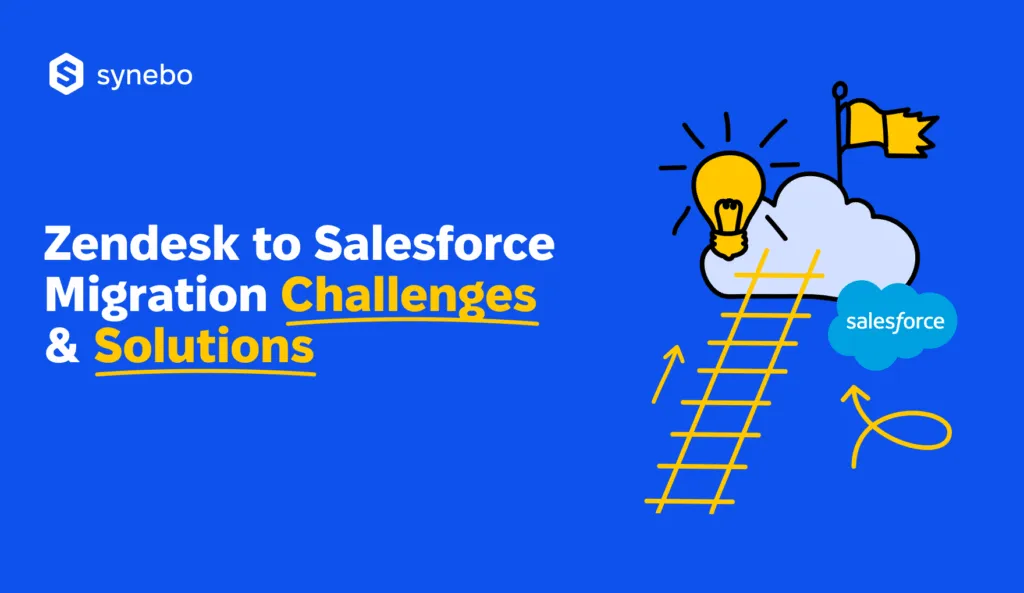
Every migration hides a cliff just past the safe path. One misstep, and years of customer records can slip away. If you are running on Zendesk, the warning signs often appear early as inconsistent records, limited visibility, and much time spent stitching together reports. At that point, a Zendesk to Salesforce migration becomes the obvious step forward.
SF brings service, sales, and operations into a single system. We’ve described what you gain in detail in the Guide and Overview of Pros & Cons of Moving.
Yet, switching systems is not a straightforward upgrade. It’s a handover where service continuity hangs in the balance. Industry surveys reveal that around 70% of data migration projects fall short of their goals, be it through damaged data quality, budget overspends, or more. The implication is clear: the risks are real.
So, what are the common migration challenges when switching from Zendesk to another tool? Say, Salesforce?
This article spotlights the challenges hiding in migration and explains how to move from Zendesk to Salesforce without breaking your customer care workflows.
Why Migration Risks Reach Beyond IT
Switching from Zendesk to Salesforce may look like a technology exercise – you follow certain tech steps and that’s it.
It’s true and false at the same time.
The thing in the “false” part of the answer is that the transition ripple effects stretch across your entire organization. Any leader who treats Zendesk data migration as “IT’s job” can quickly discover that continuity of customer experience may suffer.
So, what stakes show up? Not in code or APIs, but in the lifeline of your business itself?
- Operational continuity. Every moment of downtime or data inconsistency carries a price: missed SLAs, irritated customers, and more. Poorly-performed Zendesk to Salesforce data migration can undo years of your work in strengthening client relationships.
- Hidden complexity. Zendesk environments rarely stay untouched. Over the years, you could (and did) build layers of workflows, custom triggers, and automations. Translating this setup into SF requires interpreting the logic that keeps your daily support running.
- Impact across many teams. The transition isn’t confined to your support desk. Migration to Salesforce touches IT, CX, Commercial, and even Finance Depts. Each relies on data; one corrupted field can cascade into flawed reports and bad decisions.
- Regulatory and security risks. Moving sensitive customer details across systems poses compliance and privacy risks. Residency of data, standards for encryption, and access controls must be managed with the utmost responsibility and precision.
So, Zendesk to Salesforce (Service Сloud) migration isn’t a minor project that your IT Dept can quickly do and forget. It is a business-critical initiative. And it demands cross-functional collaboration, disciplined change management, and leadership oversight.
Zendesk to Salesforce Data Migration Challenges
As a Salesforce data migration service provider that has a really lengthy experience in the field, we can confirm: your move to SF will bring you many gains, from unlocking your scalability to deeper CRM integration.
Read Also: Pros & Cons of Moving from Zendesk to Salesforce Service Cloud
On the other hand, we will always honestly warn customers that the road there has some traps.
So, what stands in the way of the shift? And what can you do to address those hurdles?
Let’s take it from the top and go step by step.
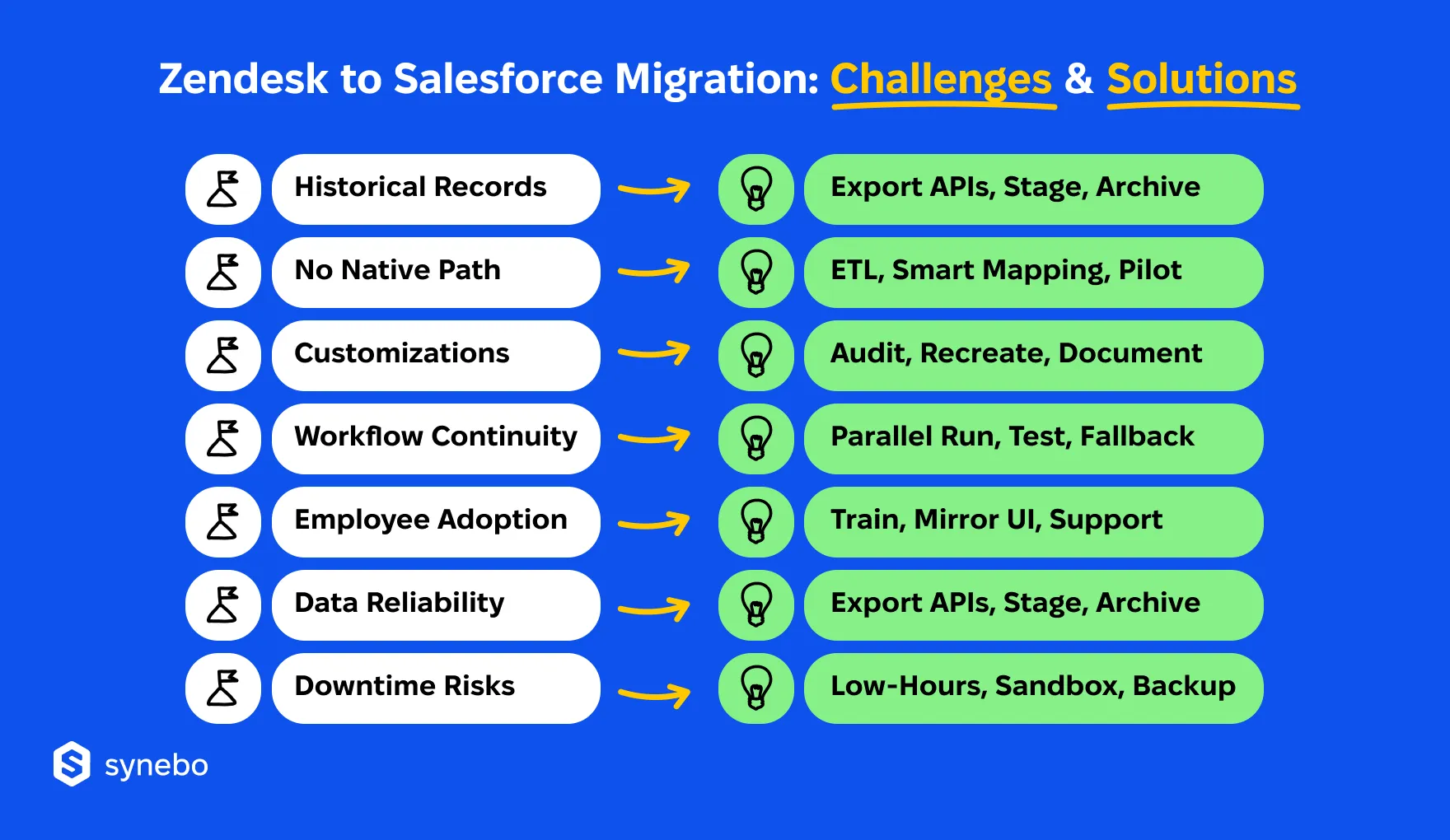
Challenge 1: Preserving Historical Records
Tickets from clients, attachments, conversations, and knowledge articles are the memory of your customer service. If you lose them when migrating to Salesforce, your help line agents will feel like surgeons asked to operate without patient history.
Your decision:
- Export everything via Zendesk APIs instead of relying on flat files. This way, relationships between objects remain OK and intact.
- Use a staging database where you can validate, clean, and deduplicate your data before the SF import.
- Split the knowledge base content into two tracks. Migrate the frequently used articles from Zendesk to Salesforce and place them into SF Knowledge. Archive low-traffic content in a searchable repository for reference.
- Handle attachments with care. SF has file size limits. So, big attachments, screenshots, and media require a phased approach (possibly chunking files or using external storage integrated with SF. Data Loader alone can fail to cope with your heavy media).
Challenge 2: No Native Migration Path
SF – alas – won’t hand you a “migrate from Zendesk to Salesforce” button. Every transition has its quirks. As companies expect a shortcut that doesn’t exist, they sometimes stumble here.
Your decision:
- Design an ETL (Extract, Transform, Load) process or use specialized migration platforms to map Zendesk objects to Salesforce equivalents.
- Treat mapping as a redesign, not a copy-paste. Your tickets become Cases, organizations convert into Accounts, and macros or triggers may evolve into SF Flows.
- Test mappings with a pilot dataset before you migrate the full volume. This will help you catch Zendesk migration issues timely – early.
Challenge 3: Rebuilding Customizations
Perhaps, it’s a repetition in other words, but still: Zendesk’s triggers, macros, and SLA rules rarely have a one-to-one equivalent in SF. If you mishandle those, your automations either break or cause conflicts.
Your decision:
- Before you migrate from Zendesk to Salesforce, audit all Zendesk automations and decide which are still relevant.
- Recreate priority rules, escalations, and SLAs in SF – use Flows, Omni-Channel, and Entitlements.
- Document each rule translation. For your future admins, it will be easier to understand why processes were rebuilt in this way.
Challenge 4: Workflow Continuity
This is probably one of the biggest fears for many businesses, when they migrate from Zendesk to the Salesforce Service Cloud. When escalations, queues, or integrations stall during the cutover, the entire support operation can grind to a halt.
Your decision:
- For a short transition period, run both systems in parallel. You can route live tickets into SF and allow your helpdesk agents to reference Zendesk for history.
- Rebuild your integrations with telephony, chat, and CRM add-ons in advance. Test them against Salesforce’s APIs.
- Create fallback workflows. This will help you resolve your urgent tickets if an integration fails in the middle of the transition process.
Challenge 5: System Acceptance by Employees
It’s another critical Salesforce data migration challenge. Overall, technology succeeds only when people embrace it. If your crew feels lost in SF, their productivity drops and their response times to customers stretch.
And this is the complete opposite result of what SF can give.
Your decision:
- Provide role-specific training (because what any team lead needs differs from what your front-line agent requires).
- Where possible, build dashboards and layouts that resemble the Zendesk experience. This eases the jump and smooths Salesforce user adoption after migration.
- Keep a “floor support” team during the first weeks post-migration (for example, admins who answer questions instantly).
Challenge 6: Data Reliability Risks
When you migrate data to Salesforce, you can find out that some links are distorted, formatting is broken, and/or attachments are lost. A missing customer thread may not sound dramatic.
Until an executive escalates a complaint.
So, your decision:
- Validate data after each Salesforce migration cycle. We recommend that you compare record counts, IDs, and relationships.
- Use checksum or hash comparisons for attachments to confirm integrity.
- Run multiple test imports before the final cutover. They – early – catch patterns of corruption.
Challenge 7: Downtime and Integration Gaps
Customer service cannot stop working. No business can afford this. Yet, rebuilding chatbots, telephony connectors, or CRM extensions can sometimes introduce outages. And this makes one of the trickiest Zendesk migration challenges to manage effectively.
Your decision:
- Schedule your transition waves during low-volume support hours. This minimizes your customer impact.
- First, build integration adapters in a sandbox. Then test them under a bigger load.
- Stage a special channel for communication with your customers (for example, temporary email or hotline) in case SF launch will happen later than you expected.
Every Zendesk-to-Salesforce migration carries risks. However, those risks shrink with foresight, disciplined planning, and pro execution.
As in life, each challenge we’ve discussed hides a solution. Our experience says that businesses that prepare thoroughly move their data intact and also give their help desk agents a stronger, more reliable environment to serve customers.
If you want to navigate these Zendesk to Salesforce data migration challenges stress-free, Synebo is here to guide you with hands-on support. Reach out to our Salesforce data migration consultants.
Keeping Your Support Running While Systems Change
It may sound too blunt, but it’s true: your customers don’t care which system you use. They care that their issue gets solved quickly.
What can you do to ensure your customer support service continues to operate effectively during your Salesforce CRM migration?
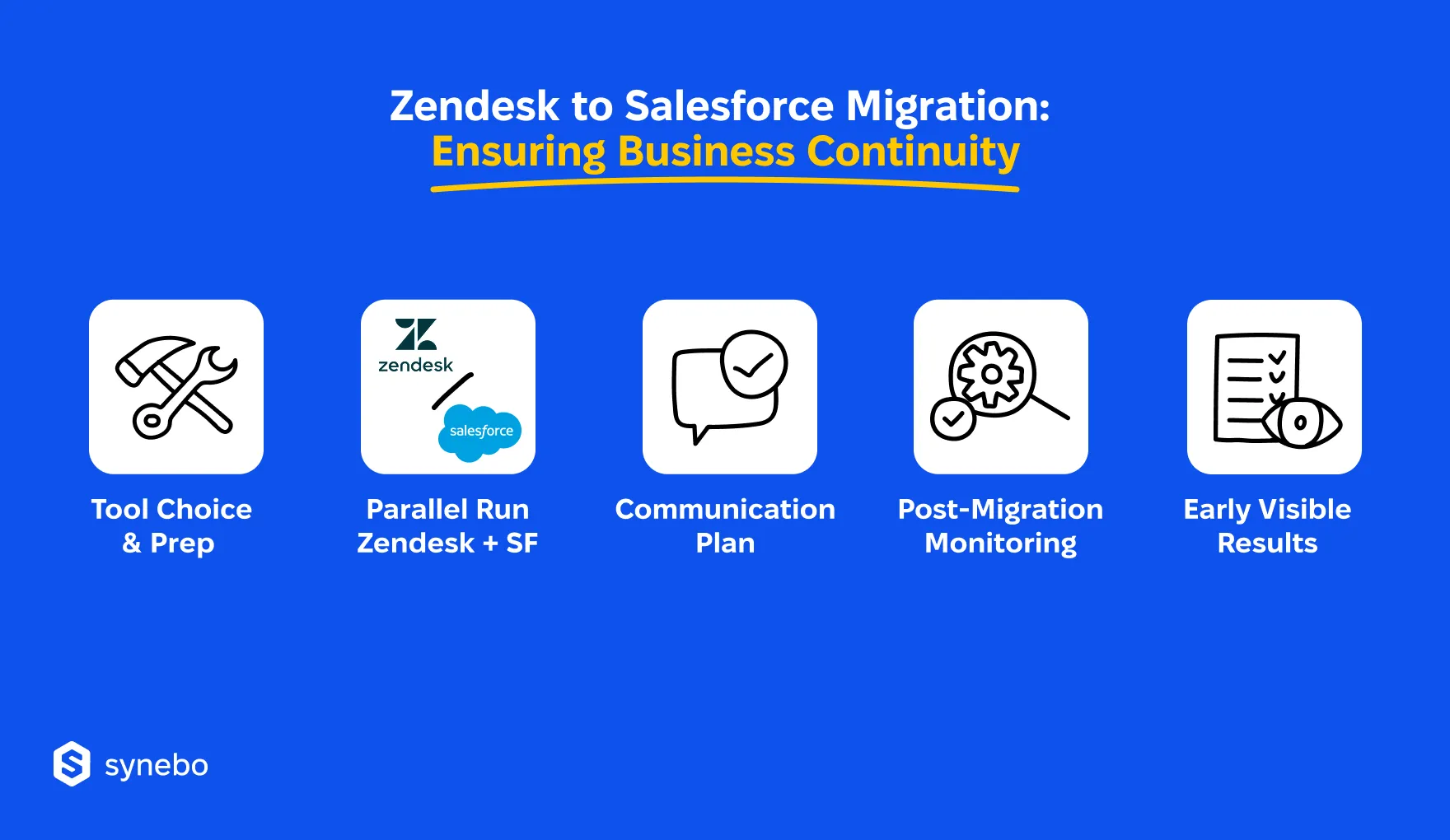
Gear Up for Painless Migration
First of all, behind every risk-free migration sits good preparation and the right toolkit. Our clients often ask us: which tools offer the most seamless migration from Zendesk?
We’ve described the preparation process and recommended three perfect tools that we use ourselves in the step-by-step Guide.
Here, let us outline the overall approaches that will help you get the most out of the Zendesk migration tools and keep the switch efficient.
So:
- Match the tool to your migration scale. Large datasets and complex histories need more robust solutions. Small transfers are OK with more nimble options.
- Mind your team’s capabilities. Pick a tool that fits your people’s comfort level. This will make SF adoption smooth from the start.
- Lean on features that save your time. Automations, easy validation, and more reduce your manual work and stress.
Read Also: Salesforce Data Migration Checklist: What to Prepare Before You Start
Run Parallel Systems, but With Boundaries
You may probably guess that turning off your old system overnight is a recipe for chaos. If you stick to a controlled overlap, as we’ve briefly mentioned above, you ensure your business doesn’t stall when migrating from Zendesk to Salesforce.
So, your steps:
- Keep Zendesk active for reference while you are routing new cases into SF. This gives your agents access to historic context.
- Set a clear time limit for dual operation – just several weeks, no more. Otherwise, your team will drift into confusion.
- Monitor the performance of both systems daily. If discrepancies happen, you can catch them before they multiply.
Communicate Relentlessly
Your support agents are the ones who explain to your customers your company is migrating to Salesforce. And if your agents feel lost, so will your clients.
To prevent this, you can:
- Share a migration timeline internally – when SF takes over, tell your crew what features change, and whom to contact if something isn’t OK.
- Prepare customer-facing messages for possible disruptions. When armed, your team doesn’t scramble under pressure.
- Keep executives informed with regular updates. Confidence effectively calms the rest of your organization during the Zendesk to Salesforce data migration.
Track Every Signal After Cutover
Going live is surely a milestone. But it’s not the finish line yet. We’ve mentioned it in our previous articles, and we’ll say it again: if you see silent glitches (such as, for example, missing attachments, slower resolution time, or broken queues), treat them as early warnings and resolve them fast.
That’s why:
- Measure what matters to your customers and business. It can be satisfaction scores, first-response times, case closure rates, and more. Do it weekly.
- Collect feedback from your agents daily after your Zendesk to Salesforce data migration. Do it during the first month – people can see problems before reports show them.
- Place monitoring dashboards where your managers can spot dips quickly.
Read Also: Zendesk to Salesforce Migration: Step-by-Step Guide for a Smooth Transition
Show Quick Wins
Your agents and leaders – actually, your whole team – need proof that the new platform pays off. Because without visible benefits you gained, Salesforce user adoption after migration may seriously lag.
For that, you can do the following:
- Give your agents full client views that combine CRM data with ticket history.
- Launch intuitive dashboards for managers that reveal workloads and trends faster than Zendesk ever did.
- Automate repetitive case-routing tasks and give your agents back precious minutes each day.
What else could we add here?
Your data migration to Salesforce isn’t judged by how well your data lands in SF (it’s still critically important. But now, we are looking at the process from your clients’ perspective).
So, from their point of view, your transition success is judged by whether your customers notice disruption.
Running parallel systems for a short period, monitoring service health, communicating gains from SF, and delivering quick wins make the difference between a switch that unsettles the business and one that strengthens it.
Make the Switch Without Losing Momentum
Switching from Zendesk to Salesforce is far from swapping one tool for another. It’s about securing a service platform that goes step-by-step with your growth. Some risks exist, and we’ve listed them above. Yet, the reward is much bigger: you get a unified environment where every customer interaction connects with the rest of your business.
To go well, your migration journey requires planning and expertise. Data wants cleansing. Automations need rethinking. Integrations demand testing. Avoid cutting corners here. Because it often results in prolonged disruptions and a frustrated team.
As a Salesforce data migration partner, Synebo has helped many firms avoid pitfalls. We know how to migrate without breaking your business continuity and how to prove SF value quickly.
Ready for the painless Zendesk to Salesforce data migration? Talk to Synebo, and let’s map out your path that gets you to SF without losing a step in customer service.


